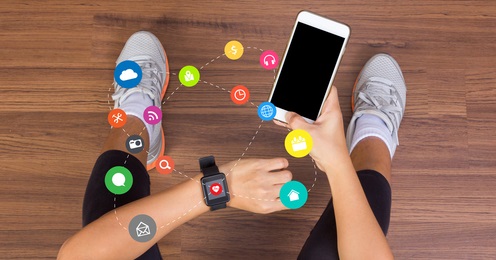Ways to boost the uptake of digital health and wellbeing tools among the workforce

An Association of British Insurance (ABI) report into wearable devices predicts that by 2018 at least 13 million wearable devices will be integrated into wellness programmes. Whether it’s wearable technology to monitor steps or sleep patterns, smartphone apps offering mindfulness coaching or nutrition advice, there is something for everyone. But it’s not enough to introduce it as a ‘nice to have’. Getting uptake and sustained use that will deliver a return for the business, takes planning and effort.
Appeal to everyone, alienate no-one
Understand your organisation’s demographics and employees needs and wants and provide options that will appeal to everyone. A one size fits all approach won’t work. You’ll only engage the already health conscious and intrinsically motivated, alienating as much as 60-80% of the workforce. Making health changes is a personal thing and an app or wearable that will work for a single male millennial, won’t work for a full time working parent.
Avoid too much of a focus on physical health apps and tools. Things like exercise tracking and weight loss programmes can be positive for some, but very negative for others, creating feelings of failure and exclusion. It’s important to take a holistic approach and appeal to physical, emotional, social and mental health factors.
The key to harnessing the power of digital is to use the tools to encourage employees to understand their own wellbeing status and take charge of what action to take. This level of personalisation will lead to greater engagement.
Get management buy-in
Lead by example and ensure management involvement. If employees see management using the tools themselves and talking about them, it starts to create a healthy culture which filters down through the organisation and encourages participation. Managers, particularly line-managers, must be shown the business benefits of staff engagement in workplace wellbeing initiatives. Appeal to their self-interest given they’re usually dealing with the fallout of poor staff health on the front line.
Make it accessible
Whether it's wearable technology or smartphone apps, user experience needs to be easy and accessible. Avoid multiple point solutions; having to remember multiple logins leads to low utilisation. Don’t assume all staff will be conversant with the technology. Offer training and appoint training ambassadors to help day to day.
Promote it constantly
Digital wellbeing tools should to be part of a wider wellbeing strategy and programme. Don’t use them in isolation, or ad hoc, because they won’t achieve long term engagement and therefore affect change. Avoid a big sign-up at launch that wanes after four weeks.
Sustained and regular communication and promotion is vital to maintain on-going engagement. Promotional initiatives can range from appointing technology wellbeing champions, a digi-health feature of the month, wellbeing challenges linked to national health initiatives and inter department competitions and collaborations. Above all make it fun and approach it as a consumer experience and not an HR one.
Be transparent about data
Be clear about your objectives for introducing digital health tools and how you will calculate ROI. If you plan to use the data from devices like fitness trackers or monitor which apps staff are using to better understand their health status and risk factors (even if it will only be used to improve your wellbeing offer to them) it may be viewed suspiciously. It’s important to dispel fears that any data generated remains anonymous and will only be used at an aggregate level.
Digital wellbeing technology is emerging almost daily. With a workforce that is made up of digital natives who embrace it ‘in their sleep’ and digital immigrants who want to stay healthier for longer, its role in the workplace will only increase.
If you want to find out more about using data, then join us for an exclusive webinar “Using data to drive employee wellbeing & engagement” held by our head of data science, Steve VanWieren on Thursday 29th June at 1pm BST. Click here to register.
James Hewitt is director of customer success (UK) at Lifeworks.
This article was provided by Lifeworks.






